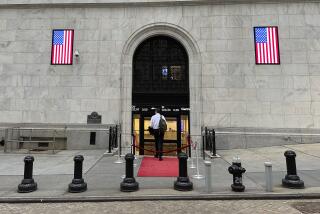Staging a Semi-Comeback? : Shares of Semiconductor Equipment Makers Have Firmed Again Lately, but Some Analysts Urge Caution, Saying It’s Not Time to Buy Yet
- Share via
Among the market’s worst-performing groups this year has been the semiconductor equipment sector, those companies that make wafer-fabrication gear, measurement gauges and other exotic goods used in producing those tiny yet powerful electronic chips.
Many of the stocks have tumbled 25% or more this year because chip makers themselves have been in a prolonged slump. An oversupply of chips has caused prices to plummet, and so producers’ need for expensive new manufacturing equipment has dried up.
“Orders for semiconductor capital equipment have plunged,” analyst Vadim Zlotnikov of the brokerage firm Stanford C. Bernstein & Co. in New York noted in a recent report.
Lately, though, chip prices have firmed again--albeit only slightly. And that’s prompted some bargain hunters to buy the chip equipment stocks again on grounds that the industry’s slide has ended. For example, Novellus Systems Inc. has bounced back about 11% since mid-September to about $43 a share, even though it’s still off about 20% for the year to date.
But if other investors are thinking of following suit, some analysts say they should think again.
The recent upswing in the semiconductor equipment stocks is “a head fake, a false start,” analyst Robert Maire of Donaldson, Lufkin & Jenrette Securities wrote in a recent report.
He ascribed the stocks’ recent gains to the slight upturn in prices for memory chips--mainly the dynamic random access memory chips, or DRAMs, that are commonplace in personal computers--and an unexpectedly strong third-quarter profit reported by chip king Intel Corp. And last week, Intel said it expects its fourth-quarter results to be even stronger than in the third quarter’s.
But the improved DRAM pricing is temporary, Maire argued, adding that “a meaningful turnaround” in both that chip market and in the demand for chip-manufacturing equipment “is unlikely to occur before mid-1997.” Recent events are “raising investors’ hopes prematurely for a recovery,” he said.
Zlotnikov agreed, saying the group probably won’t see a solid rebound until the third quarter of 1997--nearly a year from now.
The semiconductor industry is renowned for its volatility, as ever-new chip technologies and repeated tides of newly built production sites keep sending the business through jagged peaks and valleys of supply and demand.
Historically, the stocks of the chip equipment producers have lagged upturns in the semiconductor business by several months because the chip makers usually wait to make sure times have improved before they spend millions to buy new production equipment.
*
However, between 1990 and 1995 there was hope among many in Silicon Valley that the boom-and-bust cycle might be smoothing out. The semiconductor industry showed an unprecedented steady expansion through those years.
In response, the chip equipment stocks rose steadily as well. For the most part, investors needn’t have worried about being precise in when they bought or sold the stocks because the shares kept advancing anyway.
Applied Materials Inc., for instance, climbed from $5 a share in 1990 to nearly $60 in 1995 (after adjusting for splits). During the same period, sales at the Santa Clara, Calif.-based maker of wafer-fabrication gear skyrocketed from $567 million to $3 billion.
But then came this year, and Wall Street decided to punish most semiconductor-related issues (Intel being a very visible exception; its stock has doubled this year). Each company’s unique equipment, capital structure, market niche, management and size became virtually irrelevant to the general trends in their industry.
Case in point: Applied Materials. It now trades for about $28.25 a share.
If you plot the stock prices of several major equipment makers going back two years, the charts are almost identical and resemble a mountaintop. The price rises steadily from early 1995 to a peak in the fall of that year, then falls just as steadily over the next year.
The charts hold true not only for Novellus and Applied Materials, but also for Lam Research Corp., Ultratech Stepper Inc., KLA Instruments Corp. and Tencor Instruments.
One notable exception: DuPont PhotoMasks Inc., which has been rising steadily since it went public at $17 a share in June and now trades at nearly $37.
Indeed, Maire is still recommending mainly DuPont PhotoMasks out of the universe of equipment makers because the company is in diverse semiconductor markets, has strong management and has products that should keep winning orders from existing chip-making facilities--even if no new production plants break ground.
*
Yet the bearish analysts, despite urging investors to sit tight for now, do agree that the chip equipment companies have bright long-term futures because the chips themselves have such strong growth prospects worldwide.
With semiconductors being used in an increasing number of places--direct-broadcast television and auto components are just two examples--there’s little doubt that new chip-making facilities are going to be needed eventually.
But unlike 1990-95, investors this time around have to answer the question of when they think the chip market is, well, back in the chips for good.
James F. Peltz is a Times staff writer. He can be reached at james.peltz@latimes.com
(BEGIN TEXT OF INFOBOX / INFOGRAPHIC)
Start of a Turnaround?
Stocks of companies that make equipment for producing semiconductors have stabilized recently after a steep drop, but some analysts say expectations of a rally are premature.
*--*
Recent Change from Change from Stock Symbol price Sept.30 Jan.1 Applied Materials AMAT $28.25 +2.0% -28.0% Lam Research LRCX 26.75 Unch -42.0% Novellus Systems NVLS 43.00 +3.0 -20.0% Ultratech Stepper UTEK 18.25 -3.0 -29.0% Dupont PhotoMasks DPMI 31.00 +31.0 NA S&P; 500 index +6.0 +19.0
*--*
NM: Company went public in June, 1996.
Sector Shuffle
A ranking of 12 key sectors representing the U.S. economy, based on the last five days of trading on major equity markets.
*--*
Sector 5-day %chg P/E Yield P/Book ROE Rev. Q/chg Technology 5.8 30.6 1.0 7.7 22.5 26.9 Health care 5.7 27.5 1.7 7.0 23.3 15.7 Conglomerates 4.9 22.0 1.8 4.8 21.4 7.1 Consumer (non-cyc) 4.3 27.9 2.1 10.0 32.1 3.2 Financial 3.7 15.4 2.2 2.3 16.4 18.3 Transportation 2.3 25.1 1.9 2.5 13.3 10.4 Utilities 2.3 14.8 5.1 1.8 11.7 9.9 Consumer (cyclical) 2.2 16.5 2.5 3.1 18.7 9.3 Services 2.2 26.3 2.6 4.0 15.4 18.0 Capital goods 2.0 19.7 1.7 3.4 16.2 14.6 Energy 1.5 23.5 3.0 3.2 14.4 21.2 Basic materials 0.9 19.6 2.4 3.5 20.1 5.1
Sector EPS Q/chg Technology 23.2 Health care 18.8 Conglomerates 6.4 Consumer (non-cyc) 12.3 Financial 7.3 Transportation 14.0 Utilities -4.8 Consumer (cyclical) 38.5 Services 13.5 Capital goods 18.2 Energy 23.5 Basic materials -1.3
*--*
Source: Market Guide; all data as of Friday
Note: Each sector includes several industry groups, which in turn are made up of individual stocks. You can examine the industry groups and individual stocks that make up each sector at https://www.marketguide.com/MGI/HOT/ on the World Wide Web.
Chart explanation: Sectors and sector data are weighted by market capitalization.
NM: Not meaningful. P/E: Friday price divided by most recent trailing one--year earnings. Yield: Annual return of dividend based on most recent stock price and recent dividend information. P/Book: Price to book; price divided by latest available quarterly book value per share. ROE: Return on equity, most recent available trailing 12-month period. Rev. and EPS: Revenue and earnings per share, percentage change in most recent quarter versus year-ago quarter.







